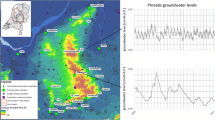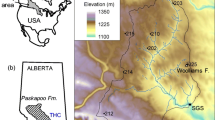Abstract
The Grand Forks aquifer, located in south-central British Columbia, Canada was used as a case study area for modeling the sensitivity of an aquifer to changes in recharge and river stage consistent with projected climate-change scenarios for the region. Results suggest that variations in recharge to the aquifer under the different climate-change scenarios, modeled under steady-state conditions, have a much smaller impact on the groundwater system than changes in river-stage elevation of the Kettle and Granby Rivers, which flow through the valley. All simulations showed relatively small changes in the overall configuration of the water table and general direction of groundwater flow. High-recharge and low-recharge simulations resulted in approximately a +0.05 m increase and a –0.025 m decrease, respectively, in water-table elevations throughout the aquifer. Simulated changes in river-stage elevation, to reflect higher-than-peak-flow levels (by 20 and 50%), resulted in average changes in the water-table elevation of 2.72 and 3.45 m, respectively. Simulated changes in river-stage elevation, to reflect lower-than-baseflow levels (by 20 and 50%), resulted in average changes in the water-table elevation of −0.48 and −2.10 m, respectively. Current observed water-table elevations in the valley are consistent with an average river-stage elevation (between current baseflow and peak-flow stages).
Résumé
L'aquifère de Grand Forks, situé en Colombie britannique (Canada), a été utilisé comme zone d'étude pour modéliser la sensibilité d'un aquifère à des modifications de la recharge et du niveau de la rivière, correspondant à des scénarios envisagés de changement climatique dans cette région. Les résultats font apparaître que les variations de recharge de l'aquifère pour différents scénarios de changement climatique, modélisées pour des conditions de régime permanent, ont un impact sur le système aquifère beaucoup plus faible que les changements du niveau des rivières Kettle et Granby, qui coulent dans la vallée. Toutes les simulations ont montré des différences relativement faibles dans la configuration d'ensemble de la nappe et dans la direction générale des écoulements. Des simulations de conditions de recharge forte et de recharge faible produisent respectivement une remontée de 0,05 m et un abaissement de 0,025 m, approximativement, des cotes de la nappe pour l'ensemble de l'aquifère. Des changements simulés de la cote du niveau de la rivière, pour refléter des niveaux plus hauts que ceux des pics de crues (de 20 et de 50%), produisent respectivement des remontées de la nappe de 2,72 et 3,45 m en moyenne. Des changements simulés de l'altitude du niveau de la rivière, pour refléter des niveaux plus bas que ceux de basses eaux (de 20 et de 50%), produisent respectivement des abaissements de la nappe de 0,48 et 2,10 m en moyenne. Les altitudes courantes observées de la nappe dans la vallée sont cohérentes avec une cote moyenne du niveau de la rivière (entre les niveaux courants de basses eaux et de crues).
Resumen
El acuífero de los Grand Forks, situado al sur de la Columbia Británica central (Canadá) ha sido utilizado como lugar de estudio para modelar la sensibilidad de un acuífero a los cambios en la recarga y el caudal de los ríos de acuerdo con escenarios previstos de cambio climático en la región. Los resultados sugieren que las variaciones en la recarga al acuífero bajo los diversos escenarios, que han sido modelados en régimen estacionario, tienen un impacto mucho menor en las aguas subterráneas que los cambios en el caudal de los ríos Kettle y Granby, que discurren por el valle. Todas las simulaciones muestran diferencias relativamente pequeñas en la configuración regional de los niveles freáticos y en la dirección general del flujo subterráneo. Las simulaciones de recarga elevada y baja causan un incremento de 0,05 m y un decremento de 0,025 m, respectivamente, en los niveles del acuífero. Los cambios de la elevación del río, simulados para reflejar niveles de flujo mayores que los valores pico (en un 20% y un 50%) resultan en cambios medios de los niveles del acuífero de 2,72 m y 3,45 m, respectivamente. Los cambios simulados en la elevación del río para flujos inferiores al caudal de base (en un 20% y en un 50%) provocan descensos en los niveles de 0,48 y 2,10 m, respectivamente. Los niveles actuales del acuífero en el valle son coherentes con una elevación media del nivel en el río (entre el caudal de base actual y los picos de caudal).














Similar content being viewed by others
References
Allen DM (2000) Numerical modeling of the Grand Forks aquifer, southern British Columbia. Report prepared for BC Ministry of Environment, Lands and Parks
Allen DM (2001) Climate-change and groundwater: a case study sensitivity analysis of the Grand Forks aquifer, southern British Columbia. Report prepared for BC Ministry of Environment, Lands and Parks
Arnell N (1996) Global warming, river flows and water resources. Wiley, Chichester, England
BC Ministry of Environment, Lands and Parks (MELP) (1999) A water conservation strategy for British Columbia, http://www.elp.gov.B.C..ca/wat/wrs/strategy/strategy.html
Boer GJ, McFarlane NA, Lazare M (1992) Greenhouse gas-induced climate-change simulated with the CCC second-generation general circulation model. J Climate 5:1045–1077
Brugman MM, Raistrick P, Pietroniro A (1997) Glacier related impacts of doubling atmospheric carbon dioxide concentrations on British Columbia and Yukon. In: Taylor E, Taylor B (eds) Responding to global climate-change in British Columbia and Yukon. Volume I of the Canada country study: climate impacts and adaptation. Environment Canada and BC Ministry of Environment, Lands and Parks
Bultot F, Coppens A, Dupriez GL, Gellens D, Meulenberghs F (1988) Repercussions of CO2 doubling on the water cycle and on the water balance—a case study for Belgium. J Hydrol 99:319–347
Bultot F, Gellens D, Spreafico M, Schadler B (1992) Repercussions of CO2 doubling on the water cycle and on the water balance—a case study for Switzerland. J Hydrol 137:199–208
Campbell AN (1971) Geohydrology of Grand Forks, British Columbia. Student report, http://wlapwww.gov.bc.ca/wat/gws/gwdocs/cgds/NTS_Files/NTS82.html
Coulson H (1997) The impacts of climate-change on river and stream flow in British Columbia and Southern Yukon. In: Taylor E, Taylor B (eds) Responding to global climate-change in British Columbia and Yukon. Volume I of the Canada country study: climate impacts and adaptation. Environment Canada and BC Ministry of Environment, Lands and Parks
Environment Canada (1993) Canadian Climate Normals 1961–90. Environment Canada, Downsview, Ontario
Environment Canada (1995) The state of Canada's climate: monitoring variability and change. Environment Canada, SOE Report 95-1
Environment Canada (1997) Responding to global climate-change in British Columbia and Yukon. Volume I of the Canada country study: climate impacts and adaptation. Taylor E, Taylor B (eds) Environment Canada and BC Ministry of Environment, Lands and Parks
Global Change Strategies International Inc. (GCSI), Environment Canada (2000) Water sector: vulnerability and adaptation to climate change. Environment Canada (http://www.gcsi.ca/downloads/ccafwater.pdf)
Guillet DW, Skinner WR (1992) The state of Canada's climate: temperature change in Canada 1895–1991. Environment Canada, SOE Report 92-2
Hansen J, Russell G, Rind D, Stone P, Lacis A, Lebedoff D, Reudy R, Travis L (1983) Efficient three-dimensional global models for climate studies: models I and II. Monthly Weather Rev 11:609–662
Hess PJ (1986) Ground-water use in Canada, 1981. NHRI Paper 28, IWD Technical Bulletin 140, National Hydrology Research Institute, Environment Canada, Ottawa, Ontario
Intergovernmental Panel on Climate Change (1995) IPCC Working Group I 1995 summary for policymakers. Report prepared by the Intergovernmental Panel on Climate Change Working Group I, World Meteorological Organization, United Nations Environment Program, Geneva
Leith RMM, Whitfield PH (1998) Evidence of climate change effects on the hydrology of streams in south-central British Columbia. Can Water Resour J 23(3):219–230
Loaiciga, HA, Valdes, JB, Vogel, R (1996) Global warming and the hydrologic cycle. J Hydrol 174(1–2):83–127
Loaiciga HA, Maidment DR, Valdes JB (2000) Climate change impacts in a regional karst aquifer, Texas, USA. J Hydrol 227(1–4):173–194
Manabe RJ, Stouffer RJ, Spelman, MJ, Bryan K (1991) Transient responses of a coupled ocean-atmosphere model to gradual changes of Atmospheric CO2, Part I: annual response. J Climate 4:785–818
Manabe RJ, Spelman MJ, Stouffer RJ (1992) Transient responses of a coupled ocean-atmosphere model to gradual changes of Atmospheric CO2, Part II: seasonal response. J Climate 5:105–126
Mekis E, Hogg WD (1999) Rehabilitation and analysis of Canadian daily precipitation time series. Atmos-Ocean 37(1):53–85
Monteith JL (1965) Evaporation and environment. Symp Soc Experiment Biol 19:205–234
Penman HL (1948) Natural evapotranspiration from open water, bare soil and grass. Proc R Soc Lond A193:120–145
Piteau Associates (1993) Design construction and testing of Grand Forks production well PW5. Consulting report.
Russell GL, Miller JR, Rind D (1995) A coupled atmosphere-ocean model for transient climate change studies. Atmos-Ocean 33:683–730
Schaffranek RW (1987) Flow model for open-channel reach or network. US Geol Surv Prof Pap 1384
Swain ED, Wexler EJ (1996) A coupled surface-water and ground-water flow model (MODBRANCH) for simulation of stream-aquifer interaction. US Geological Survey Techniques of Water-Resources Investigations, book 6, ch A6
Taylor B (1997) Climate change scenarios for British Columbia and Yukon. In: Taylor E, Taylor B (eds) Responding to global climate change in British Columbia and Yukon. Volume I of the Canada country study: climate impacts and adaptation. Environment Canada and BC Ministry of Environment, Lands and Parks
United States Department of Agriculture (USDA) (1986) Urban hydrology for small watersheds. Soil Conservation Service, Engineering Division, Technical Release 55 (TR-55)
Vaccaro JJ (1992) Sensitivity of groundwater recharge estimates to climate variability and change, Columbia Plateau, Washington. In: Lettenmaier DP, Rind D (eds) Hydrological aspects of global climate change. J Geophys Res D Atmos 97(3):2821–2833
Waterloo Hydrogeologic Inc. (WHI) (1997) Visual MODFLOW, version 2.6
Waterloo Hydrogeologic Inc. (WHI) (1999) UnSat Suite with Visual HELP, version 2.1.03
Wei M (1999) Preliminary capture zones for Grand Forks community wells. Report prepared for Grand Forks Aquifer Protection Committee, Groundwater Section, Water Management Branch, BC Ministry of Environment, Lands and Parks
Whitfield PH, Cannon AJ (2000) Recent variations in climate and hydrology of British Columbia and Yukon. Can Water Resour J 25(1):19–65
Whitfield PH, Taylor E (1998) Apparent recent changes in hydrology and climate of coastal British Columbia. In: Mountains to sea: human interaction with the hydrologic cycle. Proceedings of the Canadian Water Resources Association 51st Annual Conference, Victoria, BC, pp 22–29
Yates D, Strzepek K (1994) Potential evapotranspiration methods and their impact on the assessment of river basin runoff under climate change. International Institute for Applied Systems Analysis working paper 94-46, IIASA, Laxenburg, Austria
Acknowledgements
This study was made possible through the financial and technical support of the BC Ministry of Environment, Lands and Parks. The database that was used for development of the numerical model was assembled by the Groundwater Section, Victoria. Background information on climate-change in BC has been summarized from two publications: the BC and Yukon volume of the Canada Country Study (Environment Canada 1997) and the Water Sector Report (Global Change Strategies International Inc. (GCSI) and Environment Canada 2000).
Author information
Authors and Affiliations
Corresponding author
Rights and permissions
About this article
Cite this article
Allen, D.M., Mackie, D.C. & Wei, M. Groundwater and climate change: a sensitivity analysis for the Grand Forks aquifer, southern British Columbia, Canada. Hydrogeology Journal 12, 270–290 (2004). https://doi.org/10.1007/s10040-003-0261-9
Received:
Accepted:
Published:
Issue Date:
DOI: https://doi.org/10.1007/s10040-003-0261-9




